小升初英语知识点归纳总结
- 格式:doc
- 大小:57.00 KB
- 文档页数:7

小升初英语知识点总结
小升初英语知识点总结:
1. 词汇:
- 基本词汇:掌握常用的动词、名词、形容词、副词等基本词汇。
- 常见短语:掌握常见的短语,如问候语、道别语、感谢语等。
- 拼写:掌握常见单词的正确拼写。
2. 语法:
- 时态:掌握一般现在时、一般过去时、一般将来时等基本时态的用法。
- 句型:掌握肯定句、否定句、疑问句、祈使句等基本句型的构成和用法。
- 名词:掌握名词的单复数形式、所有格等用法。
- 形容词和副词:掌握形容词和副词的基本用法,如比较级、最高级等。
- 代词:掌握人称代词、物主代词、指示代词等的用法。
- 介词:掌握基本介词的用法,如in、on、at等。
3. 句子结构:
- 主谓宾结构:掌握主语、谓语动词和宾语的基本搭配。
- 并列句:掌握连接词如and、but、or等的用法,构成并列句。
- 复合句:掌握连接词如because、although、when等的用法,构成复合句。
4. 阅读理解:
- 理解文章:能够根据文章内容回答相关问题。
- 掌握关键词:能够通过阅读文章掌握关键词,理解文章大意。
- 阅读技巧:学会利用标题、首句、段落结构等阅读技巧,提高阅读理解能力。
5. 写作能力:
- 书写规范:掌握正确的书写规范,如大小写、标点符号等。
- 表达能力:能够用简单的语言表达自己的观点和想法。
- 句子连接:学会使用连接词和连接词组,将句子连接起来,使文章更流畅。
以上是小升初英语知识点的一些总结,希望对你有帮助。

小升初英语知识点总结重点一、名词复数的构成1. 一般情况下,在名词后加-s例如:cat - cats, dog - dogs, book - books2. 以s, x, ch, sh, o结尾的名词,在其后加-es例如:bus - buses, fox - foxes, dish - dishes, tomato - tomatoes3. 以辅音字母+y结尾的名词,变y为i再加-es。
以元音字母+y结尾的名词,在其后直接加-s。
例如:city - cities, baby - babies, boy - boys, key - keys4. 以f或fe结尾的名词,变f或fe为v再加-es。
例如:leaf - leaves, wife - wives, wolf - wolves5. 不规则名词复数形式例如:man - men, child - children, foot - feet, tooth - teeth二、形容词的比较级和最高级1.一般情况下,在形容词后加-er构成比较级,加-est构成最高级例如:tall - taller - tallest, big - bigger - biggest, small - smaller - smallest2.以e结尾的形容词,在其后直接加-r构成比较级,加-st构成最高级例如:nice - nicer - nicest, large - larger - largest3.以辅音字母+y结尾的形容词,变y为i再加-er构成比较级,加-est构成最高级例如:happy - happier - happiest, easy - easier - easiest4.以重读闭音节结尾,末尾只有一个辅音字母的形容词,要双写这个辅音字母,再加-er 构成比较级,加-est构成最高级例如:big - bigger - biggest, hot - hotter - hottest5.不规则比较级和最高级例如:good - better - best, bad - worse - worst, little - less - least三、动词的时态1. 一般现在时:主语 + 动词原形例如:I go to school every day.2. 现在进行时:主语 + am/is/are + 动词-ing形式例如:She is watching TV now.3. 一般过去时:主语 + 动词过去式例如:He played football yesterday.4. 过去进行时:主语 + was/were + 动词-ing形式例如:We were studying English at this time yesterday.5. 一般将来时:主语 + will + 动词原形例如:I will go to Beijing tomorrow.6. 现在完成时:主语 + have/has + 动词过去分词例如:She has finished her homework.7. 过去完成时:主语 + had + 动词过去分词例如:I had completed my work before she arrived.四、数词1.基数词:表示数量的词例如:one, two, three, four, five...2.序数词:表示顺序的词例如:first, second, third, fourth, fifth...3.分数:表示分数的词例如:one third, two fifths, three quarters...五、代词1.人称代词:表示人的身份或者代替人的词例如:I, you, he, she, it, we, they2.物主代词:表示所属关系的代词例如:my, your, his, her, its, our, their3.反身代词:表示动作的主语和宾语指同一人或事物的代词例如:myself, yourself, himself, herself, itself, ourselves, themselves 4.指示代词:表示指向的代词例如:this, that, these, those5.疑问代词:表示疑问的代词例如:who, whom, whose, which, what六、副词1.时间副词:表示时间的副词例如:now, then, soon, today, yesterday, tomorrow...2.地点副词:表示地点的副词例如:here, there, everywhere, anywhere, nowhere...3.方式副词:表示方式的副词例如:slowly, quickly, carefully, loudly, quietly...4.程度副词:表示程度的副词例如:very, quite, rather, too, enough...七、连接词1.并列连词:连接两个并列成分例如:and, but, or, so, for, nor, yet2.从属连词:引导并引导从句例如:when, where, if, because, although, while, since八、冠词1.定冠词:表示特指的冠词例如:the2.不定冠词:表示泛指的冠词例如:a, an九、情态动词1.can:表示能力、许可例如:I can swim. Can I go out?2.could:过去式,表示过去的能力、许可例如:I could swim. Could I go out?3.may:表示许可、可能例如:May I go out? It may rain tomorrow. 4.might:表示可能性例如:It might rain tomorrow.5.must:表示肯定、必须例如:You must do your homework.6.should:应该例如:You should listen to your parents.7.will:将要例如:I will go to Beijing tomorrow.十、介词1.表示时间的介词例如:at, in, on, during, by, for, from, to2.表示地点的介词例如:in, on, at, under, over, behind, in front of 3.表示方式的介词例如:by, with, like, as4.表示原因的介词例如:because of, due to, owing to以上就是小升初英语知识点总结,希朋友们认真学习,掌握好这些知识点,提高英语水平。
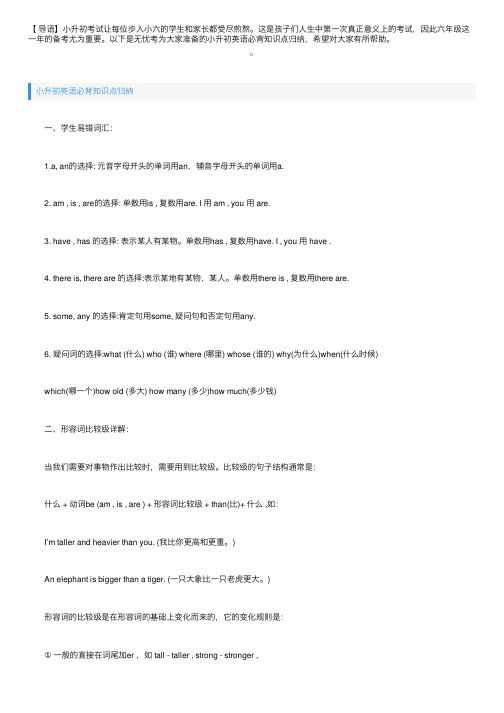
【导语】⼩升初考试让每位步⼊⼩六的学⽣和家长都受尽煎熬。
这是孩⼦们⼈⽣中第⼀次真正意义上的考试,因此六年级这⼀年的备考尤为重要。
以下是⽆忧考为⼤家准备的⼩升初英语必背知识点归纳,希望对⼤家有所帮助。
⼩升初英语必背知识点归纳 ⼀、学⽣易错词汇: 1.a, an的选择: 元⾳字母开头的单词⽤an,辅⾳字母开头的单词⽤a. 2. am , is , are的选择: 单数⽤is , 复数⽤are. I ⽤ am , you ⽤ are. 3. have , has 的选择: 表⽰某⼈有某物。
单数⽤has , 复数⽤have. I , you ⽤ have . 4. there is, there are 的选择:表⽰某地有某物,某⼈。
单数⽤there is , 复数⽤there are. 5. some, any 的选择:肯定句⽤some, 疑问句和否定句⽤any. 6. 疑问词的选择:what (什么) who (谁) where (哪⾥) whose (谁的) why(为什么)when(什么时候) which(哪⼀个)how old (多⼤) how many (多少)how much(多少钱) ⼆、形容词⽐较级详解: 当我们需要对事物作出⽐较时,需要⽤到⽐较级。
⽐较级的句⼦结构通常是: 什么 + 动词be (am , is , are ) + 形容词⽐较级 + than(⽐)+ 什么 ,如: I’m taller and heavier than you. (我⽐你更⾼和更重。
) An elephant is bigger than a tiger. (⼀只⼤象⽐⼀只⽼虎更⼤。
) 形容词的⽐较级是在形容词的基础上变化⽽来的,它的变化规则是: ①⼀般的直接在词尾加er ,如 tall - taller , strong - stronger , ②以e结尾的,直接加r ,如 fine – finer , ③以辅⾳字母加y结尾的,先改y为i再加er,如funny - funnier ④双写最后的字母再加er,如big – bigger, thin – thinner ,hot – hotter ☆注意⽐较的两者应该是互相对应的可⽐较的东西。

小升初必考英语知识点总结一、基本句型1. 主语+谓语She is singing.2. 主语+谓语+宾语They are playing basketball.3. 主语+谓语+间接宾语+直接宾语He gave me a present.4. 主语+谓语+宾语+宾补She made me happy.5. 祈使句Open the door.6. There be 句型There is a book on the desk.7. 主系表结构She looks happy.8. 被动语态The book was read by me.9. 疑问句Do you like English?10. 倒装句Not only does he play basketball, but also he plays football.二、名词1. 可数名词和不可数名词a cup of tea, two bags of rice2. 名词的所有格my father's car3. 名词的单复数a book, two books4. 特殊名词的复数形式child-children, woman-women5. 特殊名词的不可数名词形式news, information6. 特殊名词的复合名词形式forget-me-not, passer-by三、冠词1. 定冠词和不定冠词a book, the book2. 不加冠词的情况He is a student.3. 特殊用法once upon a time四、代词1. 人称代词I, you, he, she, it, we, they2. 物主代词my, your, his, her, its, our, their3. 反身代词myself, yourself, himself, herself, itself, ourselves, themselves 4. 特殊用法one another, each other五、动词1. 一般现在时He plays basketball every day.2. 一般过去时I played computer games yesterday.3. 一般将来时I will go to the park tomorrow.4. 现在进行时She is reading a book now.5. 过去进行时He was playing basketball at this time yesterday.6. 情态动词can, may, must, should, need7. 动词的不定式to do, to be8. 动词的-ing形式reading, playing9. 动词的完成时I have read that book.10. 动词的被动语态The book was read by me.11. 及物动词和不及物动词I like singing.六、形容词和副词1. 形容词的比较级和最高级big-bigger-biggest2. 副词的用法She sings well.3. 物主形容词my, your, his, her, its, our, their4. 特殊形容词和副词good-better-best, well-better-best七、介词1. in, on, at的用法in the classroom, on the desk, at home2. 特殊介词的用法under, over, between, among3. 介词短语in front of, next to, to the left of4. 介词词组on time, in time八、连词1. and, but, or的用法She likes playing basketball and football.2. because, so的用法He is tired because he works hard.3. 特殊连词的用法either...or, neither...nor, not only...but also...九、数词1. 基数词和序数词one, first2. 特殊数词的用法the first of October, one and a half 3. 特殊用法three times a week, two hours' time十、时间1. 日常时间的表达at seven o'clock, in the morning2. 一般现在时表示的未来情况I leave for Beijing tomorrow.3. 特殊时间状语的用法last Sunday, next Tuesday十一、情态动词1. can, may, must, shouldI can swim.2. 特殊情态动词的用法would like, need3. 特殊用法had better, have to十二、虚拟语气1. if引导的虚拟条件句If I were you, I would go now.2. wish引导的虚拟句I wish I were a bird.3. 特殊用法It's high time, If only十三、疑问句和感叹句1. 一般疑问句Do you like English?2. 特殊疑问句What's your name?3.感叹句What a nice day it is!四、定语和被定语1. 定语的位置和形式the red book, the book on the desk2. 被定语的位置和形式a city of the world, a boy with big eyes3. 特殊用法a cup of tea, the mother of all rivers 十五、主谓一致1. 就近原则Neither she nor I am good at singing.2. 特殊用法There be 句型十六、宾语从句1. 特殊宾语从句的引导词I know who the man is.2. 特殊宾语从句的时态I think he will come soon.十七、主语从句1. 特殊主语从句的引导词What you have said is true.2. 特殊主语从句的时态It's clear that they have won the game. 十八、定语从句1. 特殊定语从句的引导词The boy who is swimming is my friend.2. 特殊定语从句的时态I have lost the pen that you gave me.十九、状语从句1. 时间状语从句When the bell rang, we stopped working.2. 地点状语从句Where there is a will, there is a way.3. 原因状语从句Because he was ill, he didn't go to work.4. 条件状语从句If I were you, I would go now.5. 结果状语从句It's so late that we can't go out.六、语音1. 单词中元音的发音cake, team2. 单词中辅音的发音break, cream3. 单词重读音节的规律beautiful, comfortable4. 特殊音标的发音ai, ee, th七、词汇1. 同义词happy-glad, big-large2. 反义词happy-sad, big-small3. 同音词see-sea, for-four4. 词根act, behave5. 词缀happy-unhappy, Sunday-weekend 8、语法1. 句子成分的转换He doesn't like playing basketball. Playing basketball is not liked by him.2. 句子类型的转换She can swim. - Can she swim?十九、阅读1. 阅读理解阅读短文,回答问题。
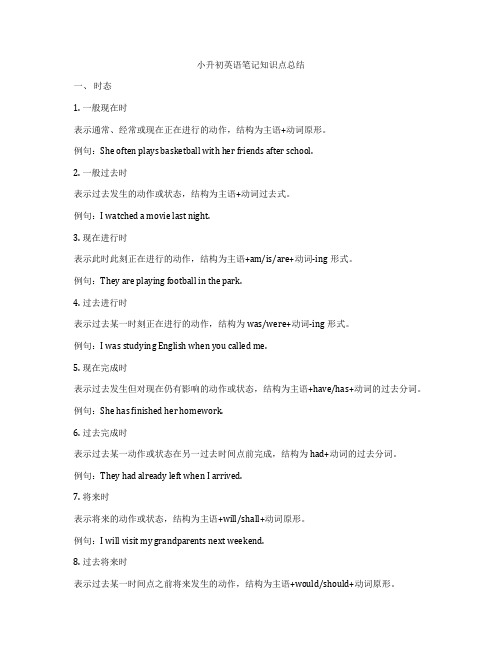
小升初英语笔记知识点总结一、时态1. 一般现在时表示通常、经常或现在正在进行的动作,结构为主语+动词原形。
例句:She often plays basketball with her friends after school.2. 一般过去时表示过去发生的动作或状态,结构为主语+动词过去式。
例句:I watched a movie last night.3. 现在进行时表示此时此刻正在进行的动作,结构为主语+am/is/are+动词-ing形式。
例句:They are playing football in the park.4. 过去进行时表示过去某一时刻正在进行的动作,结构为was/were+动词-ing形式。
例句:I was studying English when you called me.5. 现在完成时表示过去发生但对现在仍有影响的动作或状态,结构为主语+have/has+动词的过去分词。
例句:She has finished her homework.6. 过去完成时表示过去某一动作或状态在另一过去时间点前完成,结构为had+动词的过去分词。
例句:They had already left when I arrived.7. 将来时表示将来的动作或状态,结构为主语+will/shall+动词原形。
例句:I will visit my grandparents next weekend.8. 过去将来时表示过去某一时间点之前将来发生的动作,结构为主语+would/should+动词原形。
例句:He said he would come tomorrow.二、名词1. 可数名词和不可数名词可数名词表示能够数清数量的名词,可以用a或an+可数名词表示单数,也可直接使用可数名词的复数形式表示多个。
例句:There are three apples on the table.不可数名词表示不易分割、不可数清数量的名词,通常无复数形式。

小升初英语必考40个重点知识点1.时态:一般现在时、一般过去时、一般将来时、现在进行时、过去进行时、过去将来时、过去完成时、将来完成时等。
2. 人称代词:I、you、he、she、it、we、they。
3.句型转换:肯定句转否定句、否定句转肯定句、一般疑问句变否定句、否定句变一般疑问句、一般疑问句提问特殊疑问词等。
4.名词单复数:可数名词的单复数形式变化规则。
5.形容词和副词:形容词和副词的用法和比较级、最高级的规则。
6.冠词:a/an和the的用法。
7.介词:常见的介词及其使用方法。
8. 连词:and、but、or、so等的用法。
9.不可数名词与可数名词:不可数名词的用法及物品的计量法。
10.非谓语动词:动词不定式、动名词、现在分词和过去分词的基本用法。
11.动词的时态和语态:有动作的时态和语态、主动和被动语态。
12.祈使句:祈使句的用法和一般疑问句的否定回答。
13. 定语从句:关系词who, whom, whose, which和that的用法。
14.名词性从句:宾语从句、主语从句、表语从句和同位语从句的基本语法。
15.日常交际用语:问候、道别、请求、道歉等。
16.宾语:及物动词后面的宾语和介词后面的宾语。
17.数词:数字和序数词的用法。
18.频率副词:频率副词的位置和用法。
19. 情态动词:can、could、may、might等的用法。
20.反意疑问句:反意疑问句的构成和回答方式。
21.祈使句和陈述句的句型转换。
22.简单句和复合句的句型转换。
23.状语从句:时间、地点、方式等状语从句的用法。
24.英语字母和大小写的用法规则。
25.数字和时间的表达方法。
26.祈使句、感叹句和陈述句的区别。
27.人称代词和形容词性物主代词的用法。
28.祈使句的否定形式的构成和用法。
29.独立主格结构:独立主格结构的基本句型和用法。
30.定语从句和名词性从句的结构和区别。
31.特殊疑问句:特殊疑问句的基本用法和回答方式。
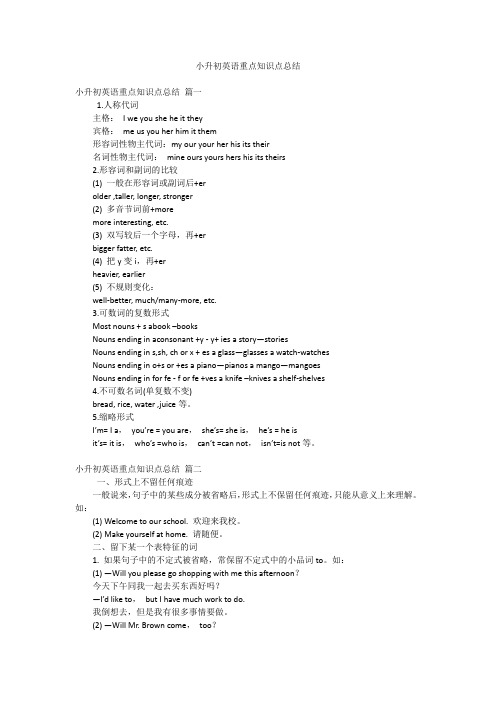
小升初英语重点知识点总结小升初英语重点知识点总结篇一1.人称代词主格:I we you she he it they宾格:me us you her him it them形容词性物主代词:my our your her his its their名词性物主代词:mine ours yours hers his its theirs2.形容词和副词的比较(1) 一般在形容词或副词后+erolder ,taller, longer, stronger(2) 多音节词前+moremore interesting, etc.(3) 双写较后一个字母,再+erbigger fatter, etc.(4) 把y变i,再+erheavier, earlier(5) 不规则变化:well-better, much/many-more, etc.3.可数词的复数形式Most nouns + s abook –booksNouns ending in aconsonant +y - y+ ies a story—storiesNouns ending in s,sh, ch or x + es a glass—glasses a watch-watchesNouns ending in o+s or +es a piano—pianos a mango—mangoesNouns ending in for fe - f or fe +ves a knife –knives a shelf-shelves4.不可数名词(单复数不变)bread, rice, water ,juice等。
5.缩略形式I’m= I a,you’re = you are,she’s= she is,he’s = he isit’s= it is,who’s =who is,can’t =can not,isn’t=is not等。
小升初英语重点知识点总结篇二一、形式上不留任何痕迹一般说来,句子中的某些成分被省略后,形式上不保留任何痕迹,只能从意义上来理解。

小升初英语最全知识点总结一、词汇名词:用于指代人、事物或抽象概念的词汇。
代词:替代名词的词语,包括人称代词、指示代词、不定代词等。
动词:表示动作、状态或行为的词语。
形容词:用于描述名词特征的词语。
副词:用于修饰动词、形容词、其他副词等。
介词:表示位置、方向、时间、原因等关系的词语。
连词:连接词语、词组或句子的词语。
冠词:用以限定名词范围的词语,包括定冠词和不定冠词。
数词:表示具体数量、顺序或比较的词语。
情态动词:表示可能性、意愿、能力等情态的助动词。
二、语法1. 句子结构:英语句子结构通常遵循主语-谓语-宾语的顺序。
例如:“Tom is reading a book.”2. 时态:英语动词的时态包括一般现在时、一般过去时、一般将来时、现在进行时、过去进行时、将来进行时等。
3. 语态:英语动词的语态包括主动语态和被动语态。
例如:“The book is read by Tom.”4. 被动语态:被动语态的构成为“be + 过去分词”,用来表示动作的承受者。
例如:“The letter was written by Mary.”5. 名词性从句:名词性从句包括主语从句、宾语从句、表语从句和同位语从句,用来充当名词的成分。
6. 宾语从句:宾语从句通常作为及物动词的宾语,由连接词引导,常用连词有that, if, whether, what, who, which等。
7. 并列连词:并列连词包括and, but, or等,用于连接并列的词语、词组或句子。
8. 介词短语:介词短语由介词和其宾语构成,用于表示位置、方向、原因、时间等。
9. 形容词和副词的比较级和最高级:形容词和副词的比较级和最高级形式的构成及用法。
10. 一般疑问句:一般疑问句的构成及回答方法。
11. 以-wh开头的特殊疑问句:特殊疑问句的构成及回答方法。
12. 物主代词:物主代词的形式及用法。
13. 反身代词:表示动作反身的代词,包括myself, yourself, himself, herself, ourselves, yourselves, themselves。
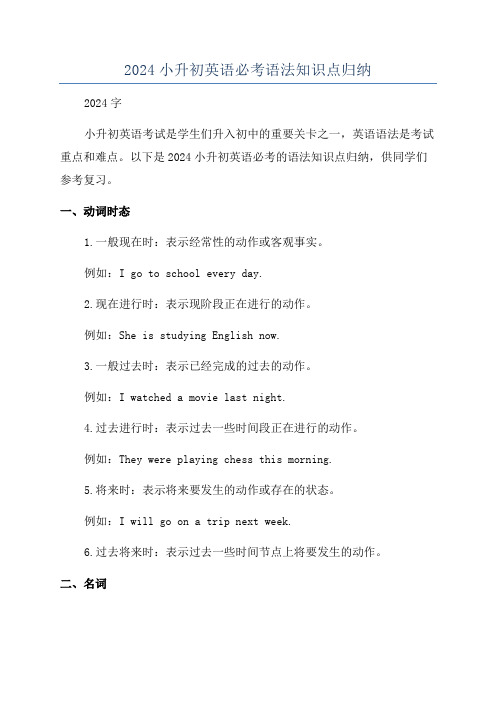
2024小升初英语必考语法知识点归纳2024字小升初英语考试是学生们升入初中的重要关卡之一,英语语法是考试重点和难点。
以下是2024小升初英语必考的语法知识点归纳,供同学们参考复习。
一、动词时态1.一般现在时:表示经常性的动作或客观事实。
例如:I go to school every day.2.现在进行时:表示现阶段正在进行的动作。
例如:She is studying English now.3.一般过去时:表示已经完成的过去的动作。
例如:I watched a movie last night.4.过去进行时:表示过去一些时间段正在进行的动作。
例如:They were playing chess this morning.5.将来时:表示将来要发生的动作或存在的状态。
例如:I will go on a trip next week.6.过去将来时:表示过去一些时间节点上将要发生的动作。
二、名词1.可数名词与不可数名词:可数名词有单数和复数之分,不可数名词只有单数形式。
例如:table(可数), water(不可数)2.名词所有格:表示所有关系时,在名词后加's。
例如:Tom's book(汤姆的书)3.复合名词:由两个或两个以上名词构成并有一定结构的名词。
例如:classroom, basketball三、形容词与副词1.形容词用来修饰名词,副词用来修饰动词、形容词或其他副词。
例如:She is a beautiful girl.(形容词修饰名词)He runs fast.(副词修饰动词)2. 形容词的比较级和最高级:一般在形容词后面加-er表示比较级,在形容词前面加the最高级。
例如:He is taller than me.(比较级)He is the tallest boy in our class.(最高级)四、代词1. 人称代词:主格形式有I, you, he, she, it, we, they;宾格形式有me, you, him, her, it, us, them。
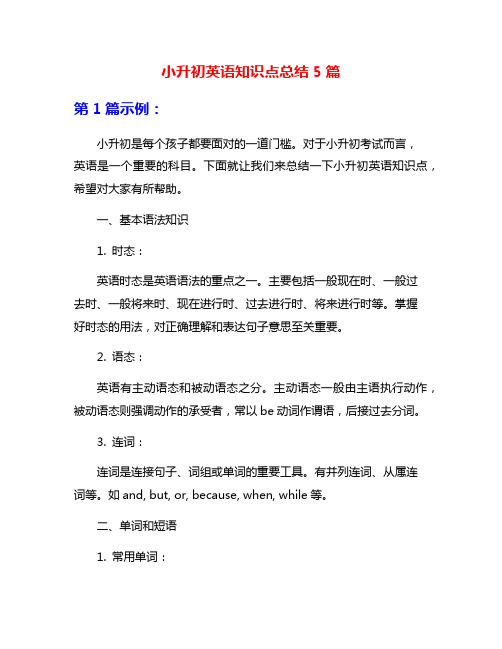
小升初英语知识点总结5篇第1篇示例:小升初是每个孩子都要面对的一道门槛。
对于小升初考试而言,英语是一个重要的科目。
下面就让我们来总结一下小升初英语知识点,希望对大家有所帮助。
一、基本语法知识1. 时态:英语时态是英语语法的重点之一。
主要包括一般现在时、一般过去时、一般将来时、现在进行时、过去进行时、将来进行时等。
掌握好时态的用法,对正确理解和表达句子意思至关重要。
2. 语态:英语有主动语态和被动语态之分。
主动语态一般由主语执行动作,被动语态则强调动作的承受者,常以be动词作谓语,后接过去分词。
3. 连词:连词是连接句子、词组或单词的重要工具。
有并列连词、从属连词等。
如and, but, or, because, when, while等。
二、单词和短语1. 常用单词:孩子们需要掌握一些常用的英语单词,如数字、颜色、家具、食物、动物等,以便顺利理解和表达一些简单的句子。
2. 常用短语:英语中有许多常用的短语,如时间短语、地点短语、动作短语等,掌握这些短语可以帮助孩子更自如地进行日常交流。
三、句型结构1. 肯定句、否定句、疑问句:英语中句型结构丰富多样,包括肯定句、否定句、一般疑问句、特殊疑问句等。
孩子们要熟练掌握这些句型的构成和用法,以便正确表达自己的意思。
2. 同位语从句:同位语从句是修饰同一名词或代词的一个从句,作用是对名词或代词进行解释说明。
掌握同位语从句的构成和用法对孩子们的英语学习至关重要。
四、阅读理解1. 看图找词:这是小学生最常见的阅读题型,要求根据图片内容填空、选择正确的单词等。
孩子们需要通过阅读图片和理解题意来做出正确的选择。
2. 短文填空:这是小升初英语阅读理解部分最常见的题型之一,要求学生根据短文内容填空,检验学生对文章的理解和词汇的掌握程度。
五、写作表达1. 作文:小升初考试英语写作部分一般要求学生完成一篇简短的文章,如日记、信件、故事等。
要求考生用简单的语言和句子表达清楚自己的观点和想法。
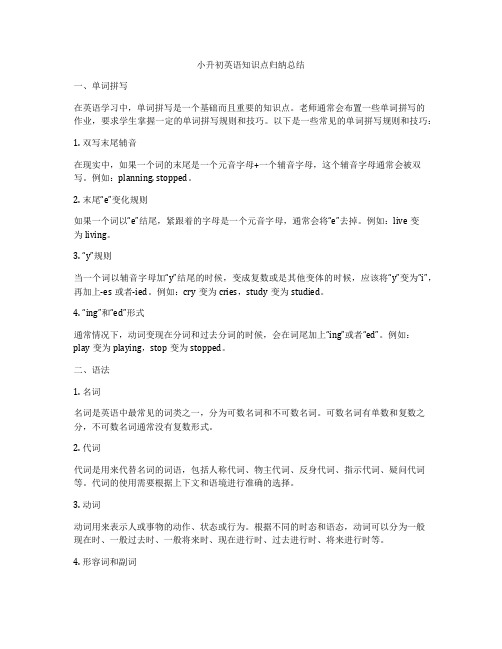
小升初英语知识点归纳总结一、单词拼写在英语学习中,单词拼写是一个基础而且重要的知识点。
老师通常会布置一些单词拼写的作业,要求学生掌握一定的单词拼写规则和技巧。
以下是一些常见的单词拼写规则和技巧:1. 双写末尾辅音在现实中,如果一个词的末尾是一个元音字母+一个辅音字母,这个辅音字母通常会被双写。
例如:planning, stopped。
2. 末尾“e”变化规则如果一个词以“e”结尾,紧跟着的字母是一个元音字母,通常会将“e”去掉。
例如:live变为living。
3. “y”规则当一个词以辅音字母加“y”结尾的时候,变成复数或是其他变体的时候,应该将“y”变为“i”,再加上-es或者-ied。
例如:cry变为cries,study变为studied。
4. “ing”和“ed”形式通常情况下,动词变现在分词和过去分词的时候,会在词尾加上“ing”或者“ed”。
例如:play变为playing,stop变为stopped。
二、语法1. 名词名词是英语中最常见的词类之一,分为可数名词和不可数名词。
可数名词有单数和复数之分,不可数名词通常没有复数形式。
2. 代词代词是用来代替名词的词语,包括人称代词、物主代词、反身代词、指示代词、疑问代词等。
代词的使用需要根据上下文和语境进行准确的选择。
3. 动词动词用来表示人或事物的动作、状态或行为。
根据不同的时态和语态,动词可以分为一般现在时、一般过去时、一般将来时、现在进行时、过去进行时、将来进行时等。
4. 形容词和副词形容词用来修饰名词,表示名词的性质、状态或特征。
副词用来修饰动词、形容词、副词等,表示动作的方式、时间、地点、程度等。
5. 介词介词是一种用来表示名词与其他词或词组之间关系的词类,常见的介词包括in, on, at, by, with, for, to等。
6. 连词连词是用来连接词、词组、句子等的词类,包括并列连词、从属连词等。
常见的并列连词有and, or, but, while等,常见的从属连词有because, if, when, although等。

小学英语知识点汇总一、名词复数规则1.一般情况下,直接加-s,如:book-books, bag-bags, cat-cats, bed-beds2.以s. x. sh. ch结尾,加-es,如:bus-buses, box-boxes, brush-brushes, watch-watches3.以“辅音字母+y”结尾,变y为i, 再加-es,如:family-families,strawberry-strawberries4.以“f或fe”结尾,变f或fe为v, 再加-es,如:knife-knives5.不规则名词复数:man-men, woman-women, policeman-policemen, policewoman-policewomen, mouse-mice child-childrenfoot-feet,.tooth-teeth fish-fish, people-people, Chinese-Chinese, Japanese-Japanese写出下列各词的复数I _________him _________this ___________her ______watch _______child _______photo ________diary ______day________ foot________ book_______ dress ________tooth_______ sheep ______box_______ strawberry _____peach______ sandwich ______dish_______bus_______ man______ woman_______二、一般现在时1.一般现在时表示经常或习惯性的动作,也可表示现在的状态或主语具备的性格和能力。
2.一般现在时中,没有be动词和情态动词,主语为第三人称单数的肯定句,动词要按规则加上s,主语是非第三人称单数的肯定句,动词用原形。
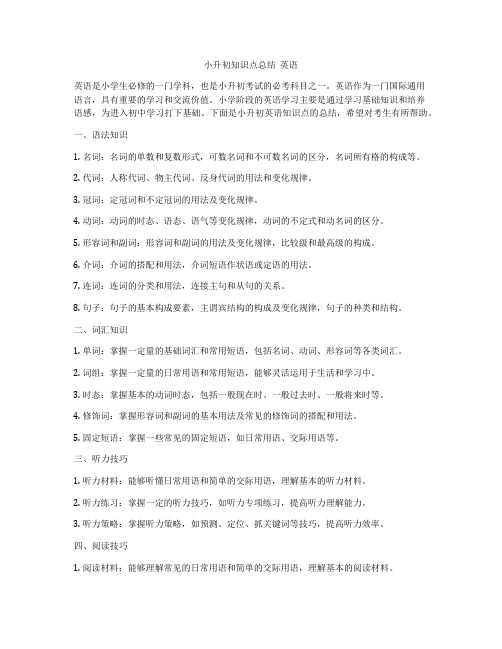
小升初知识点总结英语英语是小学生必修的一门学科,也是小升初考试的必考科目之一。
英语作为一门国际通用语言,具有重要的学习和交流价值。
小学阶段的英语学习主要是通过学习基础知识和培养语感,为进入初中学习打下基础。
下面是小升初英语知识点的总结,希望对考生有所帮助。
一、语法知识1. 名词:名词的单数和复数形式,可数名词和不可数名词的区分,名词所有格的构成等。
2. 代词:人称代词、物主代词、反身代词的用法和变化规律。
3. 冠词:定冠词和不定冠词的用法及变化规律。
4. 动词:动词的时态、语态、语气等变化规律,动词的不定式和动名词的区分。
5. 形容词和副词:形容词和副词的用法及变化规律,比较级和最高级的构成。
6. 介词:介词的搭配和用法,介词短语作状语或定语的用法。
7. 连词:连词的分类和用法,连接主句和从句的关系。
8. 句子:句子的基本构成要素,主谓宾结构的构成及变化规律,句子的种类和结构。
二、词汇知识1. 单词:掌握一定量的基础词汇和常用短语,包括名词、动词、形容词等各类词汇。
2. 词组:掌握一定量的日常用语和常用短语,能够灵活运用于生活和学习中。
3. 时态:掌握基本的动词时态,包括一般现在时、一般过去时、一般将来时等。
4. 修饰词:掌握形容词和副词的基本用法及常见的修饰词的搭配和用法。
5. 固定短语:掌握一些常见的固定短语,如日常用语、交际用语等。
三、听力技巧1. 听力材料:能够听懂日常用语和简单的交际用语,理解基本的听力材料。
2. 听力练习:掌握一定的听力技巧,如听力专项练习,提高听力理解能力。
3. 听力策略:掌握听力策略,如预测、定位、抓关键词等技巧,提高听力效率。
四、阅读技巧1. 阅读材料:能够理解常见的日常用语和简单的交际用语,理解基本的阅读材料。
2. 阅读练习:掌握一定的阅读技巧,如阅读速度、阅读技巧、理解力等。
3. 阅读理解:掌握阅读理解技巧,如理解题意、抓关键词、筛选信息等方法。
五、写作技巧1. 书写规范:掌握基本的书写规范,如字体、字形、笔画等书写技巧。
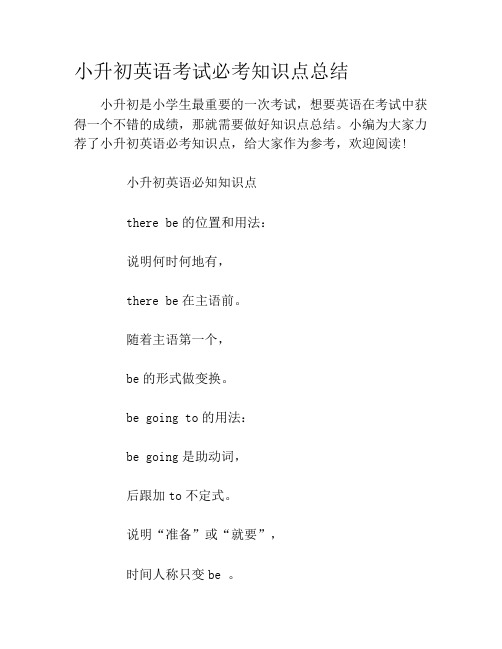
小升初英语考试必考知识点总结小升初是小学生最重要的一次考试,想要英语在考试中获得一个不错的成绩,那就需要做好知识点总结。
小编为大家力荐了小升初英语必考知识点,给大家作为参考,欢迎阅读!小升初英语必知知识点there be的位置和用法:说明何时何地有,there be在主语前。
随着主语第一个,be的形式做变换。
be going to的用法:be going是助动词,后跟加to不定式。
说明“准备”或“就要”,时间人称只变be 。
have+got:have作为动词“有”,情态动词have to;have got惯用语,got可有也可无。
若变否定和疑问,去掉got再加do;或把have提句首,not加在have后。
小升初英语必背知识点不用冠词的场合抽象、物质、专有名,代词基数用作限定; 泛指节假季节星期几,球棋、呼语与餐名;刊物、公告与标题,普通名词并列紧相邻;唯一职位,学科与语种,洲、国、省、市、县街路名。
上述口诀用心牢记,并结合下列说明予以理解①抽象、物质名词和专有名词一般无冠词,但物质名词、抽象名词具体化,或专有名词泛指时,常用不定冠词,例:a Mr Wang/a climb/a swim.for a while/in a hurry/a fire Here is a lifeof struggle.Physics is a science. There was a heavy rain last night.等抽象名词受of短语修饰或上下文已予限定,用the.如:the science of speech sounds 语音学the music of the film, do me the favor to do sth.②代数词、基数词作前置定词,不用冠词。
③泛指的节假日、季节、星期前不用冠词。
但是季节名词表特定时间或受of知识修饰时用the.如:in thewinter of 1948。
有时泛指时间用a+adj+名词。

小升初英语必背知识点归纳小升初英语必背知识点归纳一、学生易错词汇:1.a, an的选择:元音字母开头的单词用an,辅音字母开头的单词用a.2. am , is , are的选择:单数用is , 复数用are. I 用 am , you 用 are.3. have , has 的选择:表示某人有某物。
单数用has , 复数用have. I , you 用 have .4. there is, there are 的选择:表示某地有某物,某人。
单数用there is , 复数用there are.5. some, any 的选择:肯定句用some, 疑问句和否定句用any.6. 疑问词的选择:what (什么) who (谁) where (哪里) whose (谁的) why(为什么)when(什么时候)which(哪一个)how old (多大) how many (多少)how much(多少钱)二、形容词比较级详解:当我们需要对事物作出比较时,需要用到比较级。
比较级的句子结构通常是:什么 + 动词be (am , is , are ) + 形容词比较级 + than(比)+ 什么 ,如:I’m taller and heavier than you. (我比你更高和更重。
)An elephant is bigger than a tiger. (一只大象比一只老虎更大。
)形容词的比较级是在形容词的基础上变化而来的,它的变化规则是:① 一般的直接在词尾加er ,如 tall - taller , strong - stronger ,② 以e结尾的,直接加r ,如 fine – finer ,③ 以辅音字母加y结尾的,先改y为i再加er,如funny - funnier④ 双写最后的字母再加er,如big – bigger, thin –thinner ,hot – hotter☆注意比较的两者应该是互相对应的可比较的东西。
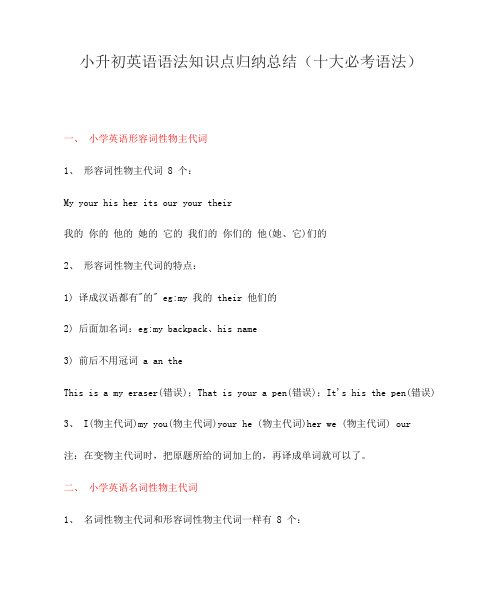
小升初英语语法知识点归纳总结(十大必考语法)
一、小学英语形容词性物主代词
1、形容词性物主代词 8 个:
My your his her its our your their
我的你的他的她的它的我们的你们的他(她、它)们的
2、形容词性物主代词的特点:
1) 译成汉语都有"的" eg:my 我的 their 他们的
2) 后面加名词:eg:my backpack、his name
3) 前后不用冠词 a an the
This is a my eraser(错误);That is your a pen(错误);It's his the pen(错误) 3、 I(物主代词)my you(物主代词)your he (物主代词)her we (物主代词) our
注:在变物主代词时,把原题所给的词加上的,再译成单词就可以了。
二、小学英语名词性物主代词
1、名词性物主代词和形容词性物主代词一样有 8 个:。

英语小升初知识点归纳总结精选8篇(实用版)编制人:__________________审核人:__________________审批人:__________________编制单位:__________________编制时间:____年____月____日序言下载提示:该文档是本店铺精心编制而成的,希望大家下载后,能够帮助大家解决实际问题。
文档下载后可定制修改,请根据实际需要进行调整和使用,谢谢!并且,本店铺为大家提供各种类型的教育资料,如演讲稿、协议书、承诺书、保证书、检讨书、作文大全、名言名句、教案大全、教学设计、其他范文等等,想了解不同资料格式和写法,敬请关注!Download tips: This document is carefully compiled by this editor.I hope that after you download it, it can help you solve practical problems. The document can be customized and modified after downloading, please adjust and use it according to actual needs, thank you!And, this store provides various types of educational materials for everyone, such as speeches, agreements, promises, guarantees, review letters, complete essays, famous quotes and sentences, lesson plans, teaching designs, other sample essays, etc. If you want to learn about different data formats and writing methods, please pay attention!英语小升初知识点归纳总结精选8篇当工作到了一定阶段或结束时,我们需要回过头来仔细分析和研究我们所做的工作,肯定我们的成就,发现问题,总结经验教训,提高认识,明确方向,以便进一步做好工作,这些都是用文字描述的,这就是工作总结。

小升初考试知识点总结英语一、词汇1. 常见的英语单词、词组和短语:如数字、颜色、家庭、身体部位、水果、食物、动物、天气、交通工具等。
2. 常见的英语动词短语:如吃早饭、看电视、打扫房间、洗衣服等。
二、语法1. 时态:一般现在时、一般过去时、一般将来时、进行时、过去进行时。
2. 人称代词:主格、宾格的用法。
3. 冠词:不定冠词a/an、定冠词the的用法。
4. 名词的单复数及所有格的变化。
5. 形容词和副词:比较级、最高级的变化规则。
6. 数词:基数词、序数词的正确使用。
7. 句子结构:主谓宾结构、主谓宾补结构、主谓双宾结构的使用。
三、阅读理解1. 阅读文章的目的:了解文章大意、抓住中心内容。
2. 阅读文章的技巧:用自己的话复述文章,了解文章的结构和语言特点。
3. 阅读文章的方法:仔细阅读每一个句子、了解每一个词语的含义。
4. 阅读文章的技巧:在阅读过程中,时刻对文章的内容进行思考和分析。
四、写作1. 日常生活类话题:如自我介绍、我的家庭、我的学校等。
2. 观察事物类话题:如观察一幅图片、一本书、一次旅行。
3. 情感体会类话题:如我最喜欢的一本书、我的愿望、我的梦想等。
4. 事件经历类话题:如一次难忘的经历、一次有趣的经历。
五、口语交际1. 问路和指路:询问路线、方向、地点。
2. 日常交际用语:问候、介绍自己、询问他人情况等。
3. 约会和活动安排:约定时间、地点、具体活动内容等。
六、听力1. 听懂简单的日常用语。
2. 听懂简单的对话和短文的主要内容。
3. 通过听力材料,了解相关信息和具体细节。
以上是小升初考试的英语知识点总结。
希望同学们能够认真学习、复习,顺利通过考试。

小升初英语知识点总结7篇篇1一、英语语法知识点1. 时态:英语中有时、态、语、非谓语动词等语法范畴。
其中,时态是英语语法中的重要概念,包括过去、现在和将来三个时态,每个时态又有简单、进行、完成等变化。
掌握时态的正确使用,可以使语言表达更加准确、生动。
2. 非谓语动词:非谓语动词是英语中一种重要的动词形式,包括不定式、动名词、分词等。
它们在句子中可以作主语、宾语、状语等成分,使语言表达更加丰富多样。
3. 从句:从句是英语中一种复杂的句子结构,包括宾语从句、状语从句、定语从句等。
掌握从句的正确使用,可以使语言表达更加精确、严密。
二、英语词汇知识点1. 基础词汇:英语基础词汇包括常用单词、短语和基本语法知识。
掌握这些基础词汇,可以为进一步学习英语打下坚实的基础。
2. 拓展词汇:在基础词汇的基础上,进一步学习相关领域的词汇,如科技、文化、艺术等。
这些词汇可以丰富语言表达,提升阅读理解能力。
3. 近义词辨析:掌握近义词的辨析和用法,可以避免因词汇混淆而产生的表达错误。
同时,近义词辨析也是提高语言精确性和表达能力的重要途径。
三、英语听说读写知识点1. 听力理解:通过听力练习,提高获取信息的能力。
在听力练习中,需要注意抓住关键词、理解主旨大意、推测生词意思等技巧。
2. 口语表达:通过模仿和练习,提高口语表达流利度和准确性。
在口语表达中,需要注意语音、语调、语速等要素的运用。
3. 阅读理解:通过阅读练习,提高理解和获取信息的能力。
在阅读练习中,需要注意理解文章主旨、抓住关键词、推测生词意思等技巧。
4. 写作表达:通过写作练习,提高书面表达能力。
在写作中,需要注意语法、拼写、标点等基本功的运用,以及如何组织文章结构和表达思想。
四、小升初英语备考建议1. 制定学习计划:根据自身情况制定合理的学习计划,确保每天都有足够的时间进行英语学习。
同时,要合理安排时间进行复习和巩固所学知识。
2. 多做练习:通过做题和模拟考试等方式进行练习,提高解题能力和应试技巧。
小学英语知识点汇总一、名词复数规则1.一般情况下,直接加-s,如:book-books, bag-bags, cat-cats, bed-beds2.以s. x. sh. ch结尾,加-es,如:bus-buses, box-boxes, brush-brushes, watch-watches3.以“辅音字母+y”结尾,变y为i, 再加-es,如:family-families,strawberry-strawberries4.以“f或fe”结尾,变f或fe为v, 再加-es,如:knife-knives5.不规则名词复数:man-men, woman-women, policeman-policemen, policewoman-policewomen, mouse-mice child-children foot-feet,.tooth-teeth fish-fish, people-people,Chinese-Chinese, Japanese-Japanese写出下列各词的复数I _________him _________this ___________her ______watch _______child _______photo ________diary ______day________ foot________book_______ dress ________tooth_______ sheep ______box_______strawberry _____peach______ sandwich ______dish_______bus_______man______ woman_______二、一般现在时1.一般现在时表示经常或习惯性的动作,也可表示现在的状态或主语具备的性格和能力。
2.一般现在时中,没有be动词和情态动词,主语为第三人称单数的肯定句,动词要按规则加上s,主语是非第三人称单数的肯定句,动词用原形。
3.在一般现在时中,句中有be动词或情态动词时,否定句在be动词和情态动词后加not,一般疑问句将be动词或情态动词放在句首。
4.在一般现在时中,句中没有be动词或情态动词时,主语为第三人称单数的否定句在动词前加does+not (doesn’t),一般疑问句在句首加does,句子中原有动词用原形;主语为非第三人称单数,否定句用do+not (don’t),一般疑问句在句首加do,句子中动词用原形。
动词+s的变化规则1.一般情况下,直接加-s,如:c ook-cooks, milk-milk s2 .以s. x. sh. ch. o结尾,加-es,如:guess-guesses, wash-washes, watch-watches, go-goes3.以“辅音字母+y”结尾,变y为i, 再加-es,如:study-studies一般现在时基本用法介绍【No. 1】一般现在时的功能1.表示事物或人物的特征、状态。
如:The sky is blue.天空是蓝色的。
2.表示经常性或习惯性的动作。
如:I get up at six every day.我天天六点起床。
3.表示客观现实。
如:The earth goes around the sun.地球绕着太阳转。
一般现在时的构成1. be动词:主语 be(am,is,are) 其它。
如:I am a boy.我是一个男孩。
2.行为动词:主语行为动词( 其它)。
如:We study English.我们学习英语。
当主语为第三人称单数(he, she,it)时,要在动词后加"-s"或"-es"。
如:Mary likes Chinese.玛丽喜欢汉语。
【No. 2】一般现在时的变化1. be动词的变化。
否定句:主语 be not 其它。
如:He is not a worker.他不是工人。
一般疑问句:Be 主语其它。
如:-Are you a student? -Yes. I am. / No, I'm not.特殊疑问句:疑问词一般疑问句。
如:Where is my bike?2.行为动词的变化。
否定句:主语 don't( doesn't ) 动词原形( 其它)。
如:I don't like bread.当主语为第三人称单数时,要用doesn't构成否定句。
如:He doesn't often play.一般疑问句:Do( Does ) 主语动词原形其它。
如:- Do you often play football?- Yes, I do. / No, I don't.当主语为第三人称单数时,要用does构成一般疑问句。
如:- Does she go to work by bike?- Yes, she does. / No, she doesn't.动词 s的变化规则1.一般情况下,直接加-s,如:cook-cooks, milk-milks2.以s. x. sh. ch. o结尾,加-es,如:g uess-guesses, wash-washes, watch-watches, go-goes3.以“辅音字母y”结尾,变y为i, 再加-es,如:study-studies用括号内动词的适当形式填空。
1. He often ________(have) dinner at home.2. Daniel and Tommy _______(be) in Class One.3. We _______(not watch) TV on Monday.4. Nick _______(not go) to the zoo on Sunday.5. ______ they ________(like) the World Cup?6. What _______they often _______(do) on Saturdays?7. _______ your parents _______(read) newspapers every day?8. The girl _______(teach) us English on Sundays.9. She and I ________(take) a walk together every evening.10. There ________(be) some water in the bottle.11. Mike _______(like) cooking.12. They _______(have) the same hobby.13. My aunt _______(look) after her baby carefully.14. You always _______(do) your homework well.15. I _______(be) ill. I’m staying in bed.16. She _______(go) to school from Monday to Friday.17. Liu Tao _______(do) not like PE.18. The child often _______(watch) TV in the evening.19. Su Hai and Su Yang _______(have) eight lessons this term.20. -What day _______(be) it today? - It’s Saturday三、现在进行时1.现在进行时表示现在正在进行或发生的动作,也可表示当前一段时间内的活动或现阶段正在进行的动作。
2.现在进行时的肯定句基本结构为be+动词ing.3.现在进行时的否定句在be后加not。
4.现在进行时的一般疑问句把be动词调到句首。
5.现在进行时的特殊疑问的基本结构为: 疑问词+ be+主语+ 动词ing?动词加ing的变化规则1.一般情况下,直接加ing,如:cook-cooking2.以不发音的e结尾,去e加ing,如:make-making, taste-tasting3.如果末尾是一个元音字母和一个辅音字母,双写末尾的辅音字母,再加ing,如:run-running, stop-stopping写出下列动词的现在分词:play________ run__________ swim _________make__________go_________ like________ write________ _ski___________read________ have_________ sing ________ dance_________put_________ see________ buy _________ love____________live_______ take_________ come ________ get_________stop_________ sit ________ begin________ shop___________二、用所给的动词的正确形式填空:1.The boy __________________ ( draw)a picture now.2. Listen .Some girls _______________ ( sing)in the classroom .3. My mother _________________ ( cook )some nice food now.4. What _____ you ______ ( do ) now?5. Look . They _______________( have) an English lesson .6.They ____________(not ,water) the flowers now.7.Look! the girls ________________(dance )in the classroom .8.What is our granddaughter doing? She _________(listen ) to music.9. It’s 5 o’clock now. We _____________(have)supper now10.______Helen____________(wash )clothes? Yes ,she is .四、将来时理论及练习一、概念:表示将要发生的动作或存在的状态及打算、计划或预备做某事。